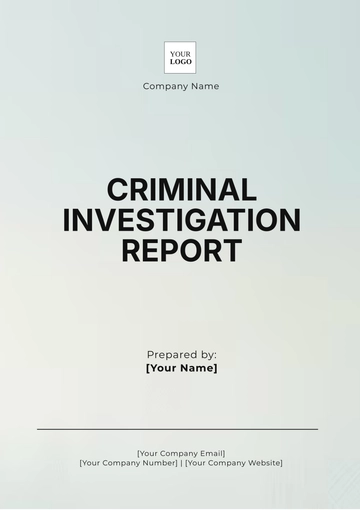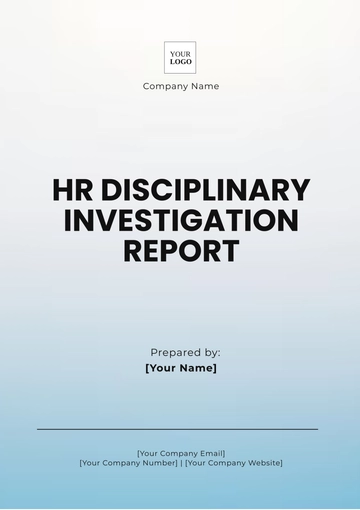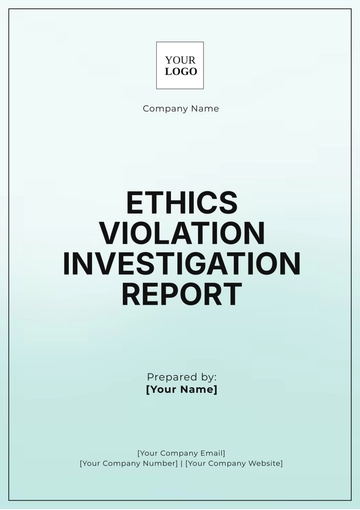Free Institutional Report

Prepared by: [YOUR NAME]
Email: [YOUR EMAIL]
I. Introduction
In the ever-evolving landscape of higher education, institutions must demonstrate their commitment to excellence and continuous improvement. This Institutional Report outlines the key components necessary for achieving and maintaining accreditation, serving as a vital tool for stakeholders to assess the quality and effectiveness of our programs.
II. Accreditation Overview
Accreditation is a process through which educational institutions are evaluated against established standards. The primary purpose is to ensure that institutions provide a quality education and adhere to regulatory requirements.
Table 1: Accreditation Standards and Compliance
Standard Category | Description | Compliance Status | Evidence Provided | Review Date |
|---|---|---|---|---|
Academic Quality | Evaluation of curriculum and faculty qualifications | Compliant | Course syllabi, faculty CVs | January 15, 2050 |
Financial Stability | Assessment of financial practices and sustainability | Compliant | Financial statements | February 20, 2050 |
Student Services | Quality of support services available to students | Compliant | Student feedback surveys | March 5, 2050 |
Governance | Effectiveness of institutional governance structures | Compliant | Governance policies | April 10, 2050 |
Institutional Planning | Long-term strategic planning effectiveness | Non-Compliant | Strategic plan document | May 15, 2050 |
Research Output | Quality and impact of research initiatives | Compliant | Research publications | June 20, 2050 |
Community Engagement | Level of involvement in community partnerships | Compliant | Partnership agreements | July 25, 2050 |
Faculty Development | Professional growth opportunities for faculty | Compliant | Training session records | August 30, 2050 |
Technology Integration | Use of technology in teaching and administration | Compliant | IT infrastructure report | September 10, 2050 |
III. Data Collection and Analysis
In preparation for the accreditation process, data was collected from various departments within the institution. This information was then analyzed to assess compliance with accreditation standards and identify areas needing improvement.
Table 2: Data Collection Timeline
Department | Data Collected | Analysis Method | Responsible Person | Collection Date |
|---|---|---|---|---|
Academic Affairs | Course performance data | Statistical analysis | Maria Turner | October 1, 2050 |
Financial Services | Budget reports | Financial ratio analysis | Jewell Ward | October 15, 2050 |
Student Affairs | Student satisfaction surveys | Qualitative analysis | Lawrence Orn | October 30, 2050 |
Institutional Research | Compliance metrics | Comparative analysis | Clint Renner | November 5, 2050 |
IT Department | Technology usage statistics | Usage pattern analysis | Elvie Block | November 15, 2050 |
IV. Findings and Recommendations
The findings from the data analysis indicate that while most areas are compliant with accreditation standards, the Institutional Planning category requires significant improvement. Recommendations include the development of a comprehensive strategic plan involving stakeholder input and regular review processes to ensure alignment with institutional goals.
V. Conclusion
As we move forward in the accreditation process, it is crucial to prioritize areas identified for improvement and foster a culture of continuous enhancement. By doing so, we will not only meet accreditation standards but also enhance the quality of education we provide to our students, ensuring their success in an increasingly competitive environment.
- 100% Customizable, free editor
- Access 1 Million+ Templates, photo’s & graphics
- Download or share as a template
- Click and replace photos, graphics, text, backgrounds
- Resize, crop, AI write & more
- Access advanced editor
The Institutional Report Template from Template.net offers a fully customizable and editable design to suit your organization's reporting needs. Simplify report creation with this professional template, perfect for delivering clear and concise information. Easily modify with the AI Editor Tool, ensuring seamless customization for your specific requirements. Get a polished, tailored report effortlessly.
You may also like
- Sales Report
- Daily Report
- Project Report
- Business Report
- Weekly Report
- Incident Report
- Annual Report
- Report Layout
- Report Design
- Progress Report
- Marketing Report
- Company Report
- Monthly Report
- Audit Report
- Status Report
- School Report
- Reports Hr
- Management Report
- Project Status Report
- Handover Report
- Health And Safety Report
- Restaurant Report
- Construction Report
- Research Report
- Evaluation Report
- Investigation Report
- Employee Report
- Advertising Report
- Weekly Status Report
- Project Management Report
- Finance Report
- Service Report
- Technical Report
- Meeting Report
- Quarterly Report
- Inspection Report
- Medical Report
- Test Report
- Summary Report
- Inventory Report
- Valuation Report
- Operations Report
- Payroll Report
- Training Report
- Job Report
- Case Report
- Performance Report
- Board Report
- Internal Audit Report
- Student Report
- Monthly Management Report
- Small Business Report
- Accident Report
- Call Center Report
- Activity Report
- IT and Software Report
- Internship Report
- Visit Report
- Product Report
- Book Report
- Property Report
- Recruitment Report
- University Report
- Event Report
- SEO Report
- Conference Report
- Narrative Report
- Nursing Home Report
- Preschool Report
- Call Report
- Customer Report
- Employee Incident Report
- Accomplishment Report
- Social Media Report
- Work From Home Report
- Security Report
- Damage Report
- Quality Report
- Internal Report
- Nurse Report
- Real Estate Report
- Hotel Report
- Equipment Report
- Credit Report
- Field Report
- Non Profit Report
- Maintenance Report
- News Report
- Survey Report
- Executive Report
- Law Firm Report
- Advertising Agency Report
- Interior Design Report
- Travel Agency Report
- Stock Report
- Salon Report
- Bug Report
- Workplace Report
- Action Report
- Investor Report
- Cleaning Services Report
- Consulting Report
- Freelancer Report
- Site Visit Report
- Trip Report
- Classroom Observation Report
- Vehicle Report
- Final Report
- Software Report





























